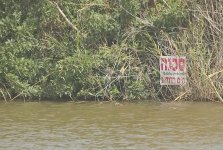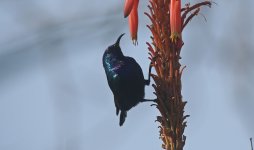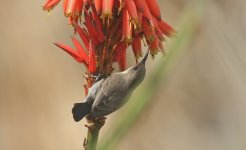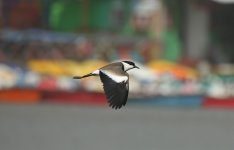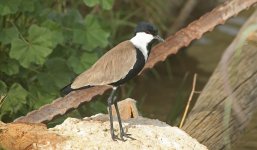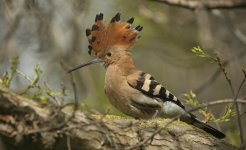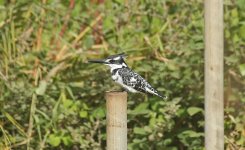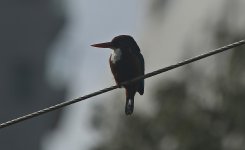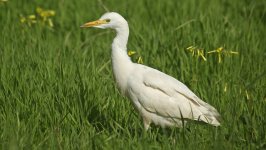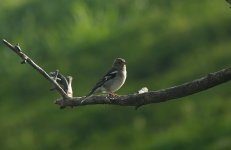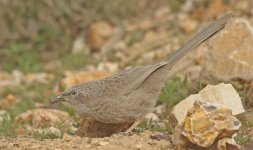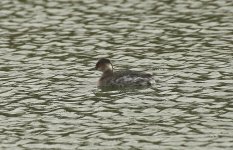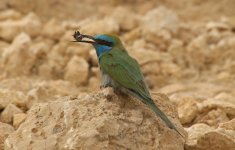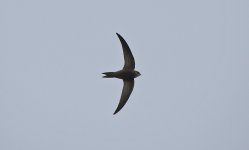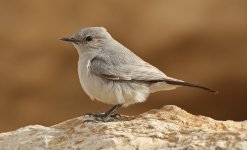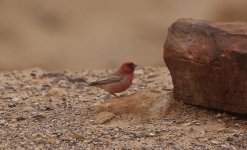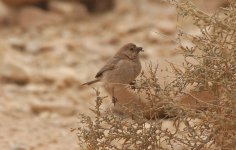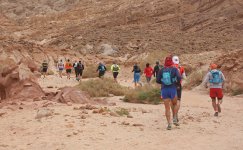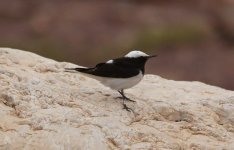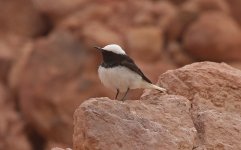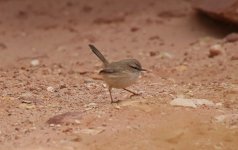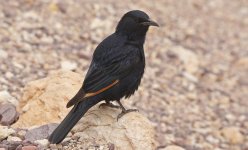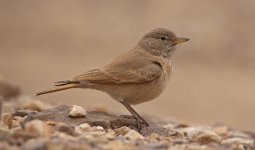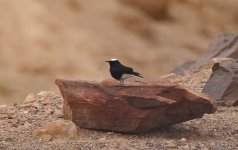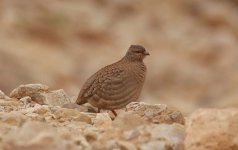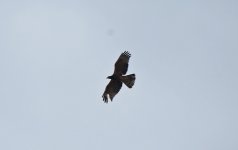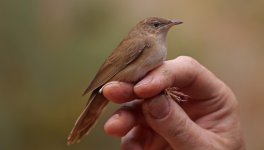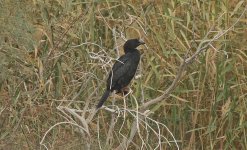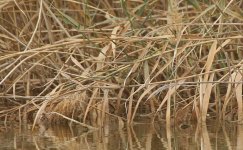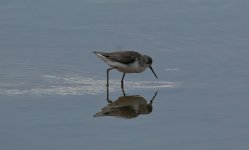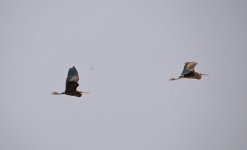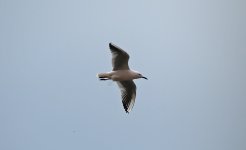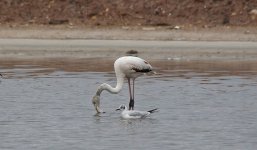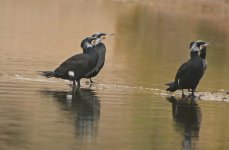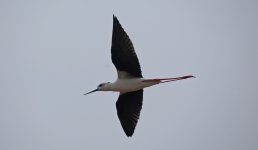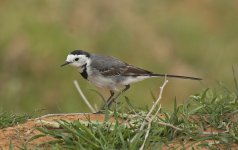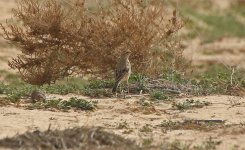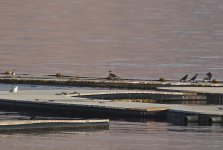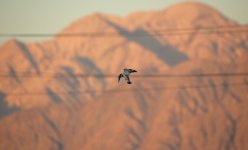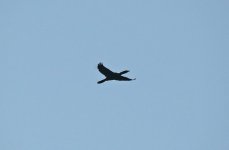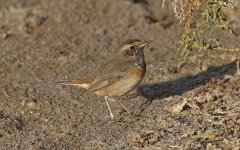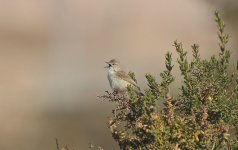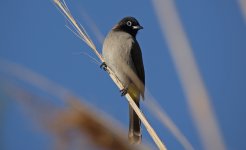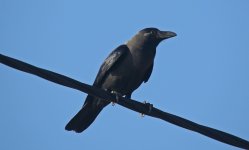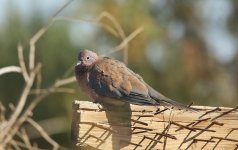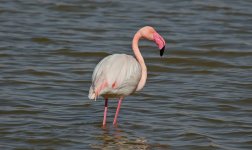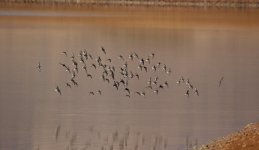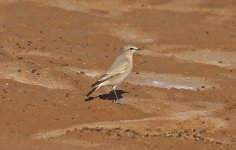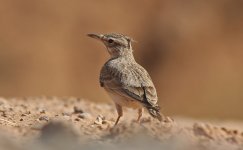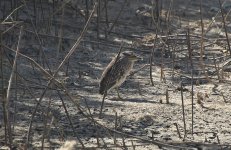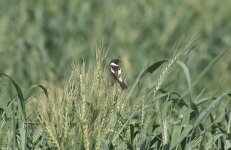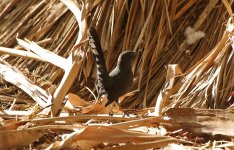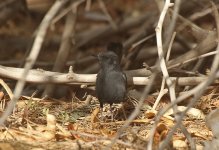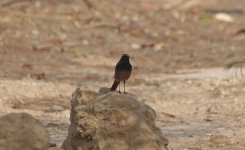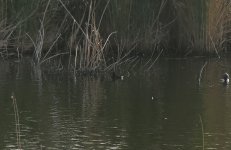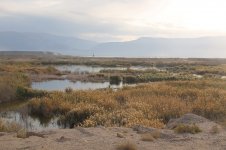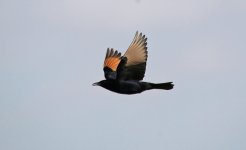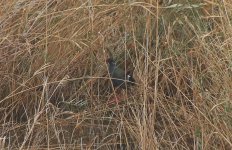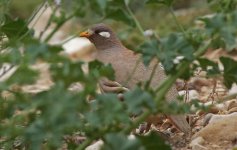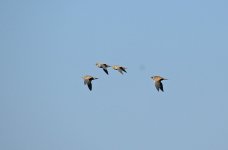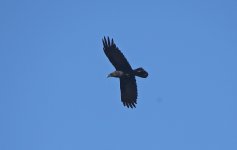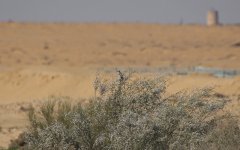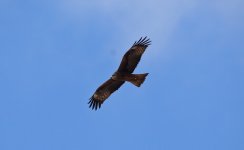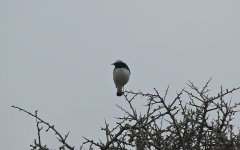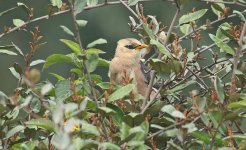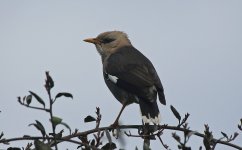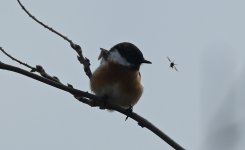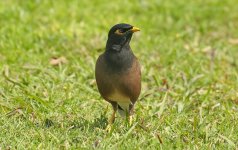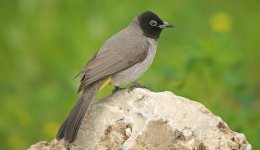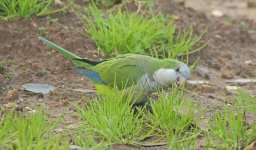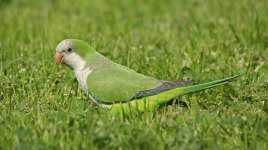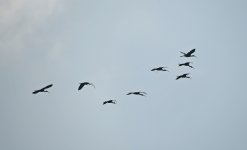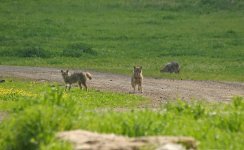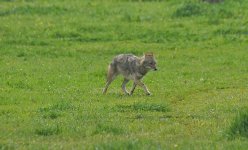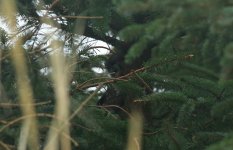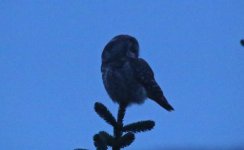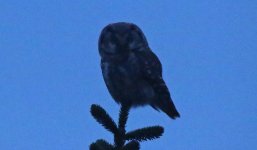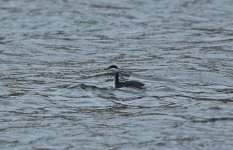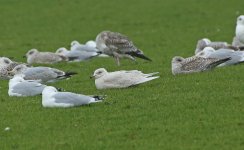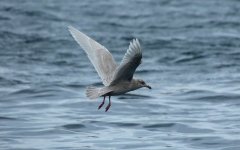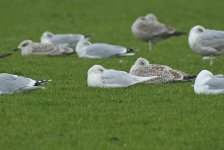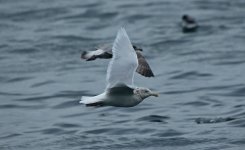I had recorded 134 species on the Israel leg of the trip:-
1 Egyptian Goose – up to 10 seen on both visits to Hayarkon Park on 15th & 20th February
2 Shelduck* - up to 20 seen on the K20 pools on 17th February
3 Muscovy Duck – two seen on the river at Hayarkon Park on 15th February; so many feral populations that I tend to record this species when ‘at large’
4 Shoveler – good numbers seen at K19 & K20 pools on 17th February, on both visits to Ashalim Reservoir on 18th February and at Nizzana drinking pools on 19th February
5 Gadwall – maybe 10 seen on both visits to Ashalim Reservoir on 18th February
6 Wigeon* - three seen on the morning visit to Ashalim Reservoir on 18th February
7 Mallard – seven sightings – Hayarkon Park, Yeruham Lake, Ashalim Reservoir and Nizzana drinking pools
8 Pintail – maybe 40 seen between IBRCE, K19 and K20 on 17th February and both visits to Ashalim Reservoir on 18th February
9 Eurasian Teal - six sightings – Yeruham Lake, K19, K20, Ashalim Reservoir and Nizzana drinking pools
10 Pochard – seen on both visits with up to five at Ashalim Reservoir on 18th February
11 Ferruginous Duck – up to 10 seen on both visits to Ashalim Reservoir and a single at Heimar Reservoir on 18th February
12 Sand Partridge – a pair at Amram's Pillars on 16th February and a pair seen on both visits to the Pharaoh Eagle Owl site near Idan on 18th February
13 Chukar* - sightings from Yeruham Lake on 15th February and Mount Amasa on 19th February
14 Greater Flamingo – nine sightings of up to 100 between IBRCE, North Beach & K20 during 16th and 17th February
15 Little Grebe - nine sightings between Yeruham Lake, IBRCE, Ashalim Reservoir, Heimar Reservoir & Nizzana drinking pools
16 Black-necked Grebe – single at Yeruham Lake on 15th February
17 Feral Pigeon – widely recorded
18 Eurasian Collared-Dove – widely recorded
19 Laughing Dove – widely recorded with sightings at Bat Yam, IBRCE, K19, Samar Jungle, Ein Gedi, Nizzana drinking pools & Yeruham Lake
20 Black-bellied Sandgrouse – four at Nizzana drinking pools on 19th February
21 Macqueen's Bustard* - two at km 7 along the Ezuz Road on 19th February
22 Alpine Swift* - one at Ben Gurion memorial park on 15th February
23 Common Swift* - most sightings identified as Common from Bat Yam, Yeruham Lake, Ben Gurion memorial park & IBRCE but tricky to separate as always
24 Pallid Swift – good numbers on both visits to Yeruham Lake and Ashalim Reservoir but tricky to separate as always
25 Water Rail* - single at IBRCE on 16th February
26 Moorhen – six sightings from Hayarkon Park, K19, Ashalim Reservoir, Nizzana drinking pools and Yeruham Lake
27 Coot – seven sightings from Hayarkon Park, Yeruham Lake, K19, Ashalim Reservoir, and Nizzana drinking pools
28 African Swamphen – up to four seen on both visits to Ashalim Reservoir on 18th February
29 Black-winged Stilt – ten sightings from IBRCE, North Beach, K20 & Ashalim Reservoir
30 Spur-winged Lapwing – widely recorded – Hayarkon Park, Yeruham Lake, IBRCE, North Beach, K20, Yotvata, Samar Jungle and Nizzana drinking pools
31 Ringed Plover* - four at North Beach Lagoon and Canal on 17th February
32 Ruff – small numbers at IBRCE and North Beach on 16th and 17th February and a flock of 30 at Nizzana drinking pools on 19th February
33 Temminck's Stint* - single at North Beach Lagoon and Canal on 16th and 17th February
34 Little Stint – two at North Beach Lagoon and Canal and 70 at K20 on 17th February
35 Common Sandpiper – two at North Beach Lagoon and Canal on 16th and 17th February
36 Green Sandpiper – four sightings of up to five - North Beach Lagoon and Canal, K19, K20 and Nizzana drinking pools
37 Greenshank – three sightings of singles - North Beach Lagoon and Canal and IBRCE on 17th February
38 Marsh Sandpiper – seven sightings of up to three – IBRCE, North Beach Lagoon and Canal and K20 on 16th and 17th February
39 Redshank – seven sightings of up to four – IBRCE, North Beach Lagoon and Canal and K20 on 16th and 17th February
40 Arctic Skua* - a single seen in strong winds at Bat Yam on 15th February
41 Slender-billed Gull – seven sightings of up to forty – IBRCE, North Beach Lagoon and Canal and K20 on 16th and 17th February
42 Black-headed Gull – widely recorded – Bat Yam, Hayarkon Park, IBRCE, North Beach, Dolphin Reef and K20
43 White-eyed Gull – sixteen recorded at Dolphin Reef on 16th February
44 Yellow-legged Gull – identified as the default large white headed gull from Bat Yam, Hayarkon Park, North Beach, Dolphin Reef and IBRCE
45 Caspian Gull – not an officiando of large white headed gulls but identified from Bat Yam, IBRCE and Hayarkon Park on 15th, 17th and 20th February
46 Armenian Gull* – not an officiando of large white headed gulls but singles identified from IBRCE and Hayarkon Park on 17th and 20th February
47 Lesser Black-backed Gull – single fuscus identified from Bat Yam on 15th February and K20 and IBRCE on 17th February and single heuglini identified from Park Hayarkon on both visits and IBRCE and K20 on 15th, 16th, 17th and 20th February. It may be that I misidentified some barbarensis as heuglini?
48 Gull-billed Tern – singles at IBRCE on 16th and 17th February
49 Caspian Tern* - two at IBRCE on 16th February
50 Pygmy Cormorant – a single at IBRCE on 16th and 17th February
51 Great Cormorant – widely recorded – Bat Yam, Hayarkon Park, Yeruham Lake, IBRCE, North Beach, K19 and K20
52 Grey Heron – widely recorded – Hayarkon Park, Yeruham Lake, IBRCE, Dolphin Reef, North Beach, K19 and K20
53 Purple Heron – two seen at IBRCE on 16th and 17th February
54 Great White Egret – seven sightings – Yeruham Lake, IBRCE and North Beach Lagoon and Canal
55 Little Egret – ten sightings with a highest count of five – Bat Yam, Hayarkon Park, Yeruham Lake, IBRCE and North Beach Lagoon and Canal
56 Cattle Egret – four sightings of up to thirty – Hayarkon Park, Yeruham Lake and Nizzana drinking pools
57 Striated Heron – single at Hayarkon Park on 15th February
58 Black-crowned Night-Heron – five sightings – three at Hayarkon Park on 15th February, up to 20 at IBRCE on 16th and 17th February and singles at K19 and Yeruham Lake on 17th and 19th February
59 Glossy Ibis – up to 12 at Hayarkon Park on both visits
60 Oriental Honey-buzzard – two at IBRCE on 16th February
61 Griffon Vulture* - single at Wadi Mishmar on 18th February
62 Steppe Eagle – single at K19 on 17th February
63 Eurasian Marsh-Harrier – six sightings – IBRCE, North Beach and Lagoon, K19 and Ashalim Reservoir
64 Black Kite – five sightings mainly whilst travelling with a concentration of 240 along Route 25 on 15th February
65 Common Buzzard – six sightings of singles including three whilst travelling plus Ben Gurion Airport, Zikim Beach and IBRCE
66 Hoopoe – up to five at Hayarkon Park on 15th February, a single at Wadi Mishmar and four at Sheizaf Nature Reserve on 18th February
67 Kingfisher – a single at Yeruham Lake on 19th February
68 White-throated Kingfisher – singles at Hayarkon Park on 15th February and IBRCE on 16th and 17th February
69 Pied Kingfisher – four sightings – Hayarkon Park, Yeruham Lake and IBRCE
70 Green Bee-eater – eight sightings – Yeruham Lake, IBRCE, North Beach Lagoon and Canal, Yotvata, Samar Jungle, Ashalim Resevoir and near Idan
71 Kestrel* - seven sightings – mainly when travelling but also Bat Yam, Zikim Beach and Mount Amasa
72 Lanner – single at Ben Gurion memorial park on 15th February
73 Rose-ringed Parakeet – five sightings – Bat Yam, Hayarkon Park, IBRCE and North Beach Lagoon and Canal
74 Monk Parakeet – around 100 seen on both visits to Hayarkon Park – 15th and 20th February
75 Great Grey Shrike – singles at Amram's Pillars on 16th February and at Nizzana Fortress and Nizzana drinking pools on 19th February
76 Jay* - single at Hayarkon Park on 20th February
77 Jackdaw – up to ten at Hayarkon Park on both visits – 15th and 20th February
78 House Crow – up to 20 seen around Eilat – IBRCE, North Beach and Dolphin Reef on 16th and 17th February
79 Hooded Crow – widely seen on the northern half of the trip – Ben Gurion Airport, Bat Yam, Hayarkon Park, Zikim Beach, Yeruham Lake, Ben Gurion memorial park and Nizzana drinking pools
80 Brown-necked Raven – four sightings – five at Yeruham Lake on 15th February and three sightings around Nizzana on 19th February
81 Fan-tailed Raven* - two from Ein Gedi carpark on 18th February
82 Raven – two seen whilst travelling on 15th February and two at Yeruham Lake on 19th February
83 Desert Lark – five sightings – Amram’s Pillars, Wadi Mishmar, near Idan and Sheizaf Nature Reserve
84 Woodlark* - a single at Mount Amasa on 19th February
85 Skylark* - seen when travelling on Route 6 on 20th February
86 Crested Lark – widely seen – a dozen sightings
87 Rock Martin – widely seen – fifteen sightings
88 Swallow* - widely seen on all bar one day
89 House Martin* - five sightings - Yeruham Lake, IBRCE and K20
90 Great Tit* - seen on both visits to Hayarkon Park and at Mount Amasa on 15th, 19th and 20th February
91 Penduline Tit – two at IBRCE on 17th February
92 White-spectacled Bulbul – very widely seen
93 Scrub Warbler – two at Amram's Pillars on 16th February and a single at Nizzana drinking pools on 19th February
94 Cetti's Warbler* - singles at Yeruham Lake on 15th February and IBRCE on 17th February
95 Chiffchaff* - widely seen - a dozen sightings
96 Moustached Warbler – single at IBRCE on 16th February
97 Sedge Warbler – singles at IBRCE on 16th and 17th February
98 Reed Warbler* – single at IBRCE on 17th February
99 Clamorous Reed Warbler* - singing birds on both visits to Ashalim Reservoir and Heimar Reservoir on 18th February
100 Savi's Warbler – single in the hand at IBRCE on 16th February
101 Graceful Prinia – widely seen – seventeen sightings
102 Lesser Whitethroat* – single at IBRCE on 16th February
103 Sardinian Warbler – widely seen - eleven sightings with ten in Wadi Mishmar on 18th February all stubbornly avoiding being a Cyprus Warbler
104 Spectacled Warbler* - sightings in Wadi Mishmar on 18th February and at Mount Amasa on 19th February
105 Arabian Babbler – sightings on both visits to Yeruham Lake and at Ben Gurion memorial park on 15th and 19th February
106 Black Scrub Robin – at least two in the Samar 'Jungle' on 17th February
107 Robin* – singles at IBRCE on 16th and 17th February and Yeruham Lake on 19th February
108 Bluethroat - six sightings – IBRCE, K19, Heimar Reservoir, Nizzana drinking pools and Yeruham Lake with at least ten at K19 on 17th February
109 Black Redstart – four sightings – Mitzpe Ramon, Samar ‘Jungle’, Sheizaf Nature Reserve and Mount Amasa
110 European Stonechat – widely seen – thirteen sightings
111 Siberian Stonechat – only one confirmed with a single at Yotvata on 17th February
112 Blackstart – widely seen - Ben Gurion memorial park, Amram’s pillars, Uvda valley, Samar ‘Jungle’, Wadi Mishmar and Ein Gedi carpark
113 White-crowned Black Wheatear – three sightings - Amram's Pillars, Uvda valley and Ein Gedi carpark with five in the Uvda valley on 16th February
114 Hooded Wheatear – singles at Amram's Pillars on 16th and 17th February
115 Finsch's Wheatear – at least five at Mount Amasa on 19th February
116 Desert Wheatear* - single in the Uvda valley on 16th February
117 Isabelline Wheatear – singles in the Uvda valley, at K20 and at Sheizaf Nature Reserve on 16th, 17th and 18th February
118 Song Thrush* - singles at Hayarkon Park and Wadi Mishmar on 15th and 18th February
119 Starling – four at Hayarkon Park on 20th February
120 Common Myna – widely seen – Bat Yam, Hayarkon Park, Zikim Beach, Ben Gurion memorial park, Yotvata and Ein Gedi
121 Vinous-breasted Starling – eight at Hayarkon Park on 20th February
122 Tristram's Starling – six at Yeruham Lake on 15th February, two at Amram’s Pillars on 16th February and around 150 around the Dead Sea and Wadi Mishmar on 18th February
123 Palestine Sunbird – five sightings – Hayarkon Park, Sheizaf Nature Reserve, near Idan, Nizzana Fortress and Yeruham Lake
124 Western Yellow Wagtail* - a single at K19 on 17th February
125 White Wagtail – very widely seen with a concentration of 100 at North Beach Lagoon and Canal on 17th February
126 Tawny Pipit – two in the Uvda valley on 16th February
127 Water Pipit* - singles at North Beach Lagoon and Canal and Nizzana drinking pools on 17th and 19th February
128 Chaffinch – singles at Hayarkon Park on both visits – 15th and 20th February
129 Sinai Rosefinch – three males and six females at Amram's Pillars on 16th February
130 Greenfinch* - single at Ben Gurion memorial park on 15th February
131 Eurasian Linnet – ten at Mount Amasa on 19th February
132 Corn Bunting* - seen when travelling on Route 6 on 20th February
133 House Sparrow – widely seen – sixteen sightings
134 Spanish Sparrow – five sightings – Uvda valley, Yotvata, Amram’s Pillars approach track, Sheizaf Nature Reserve abd Nizzana drinking pools
*34 species not photographed




